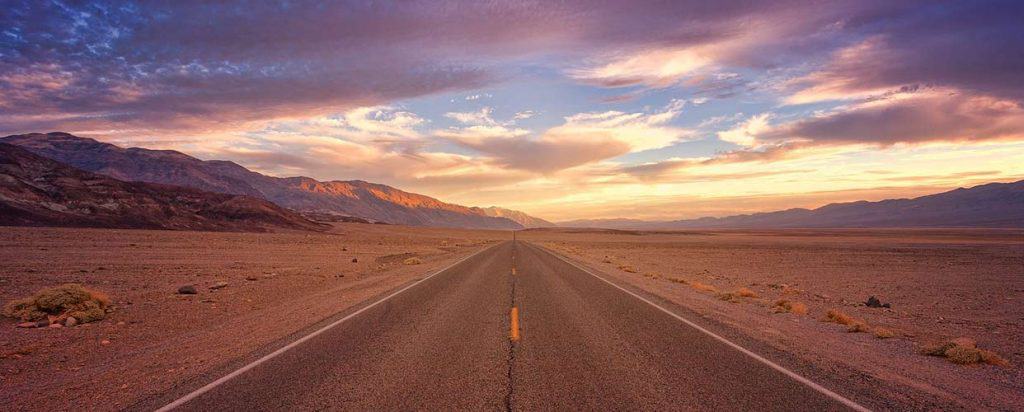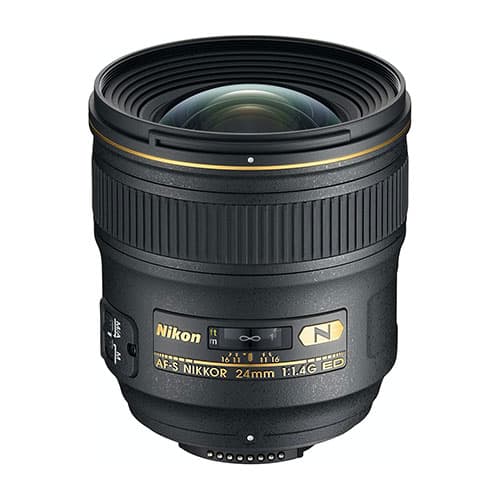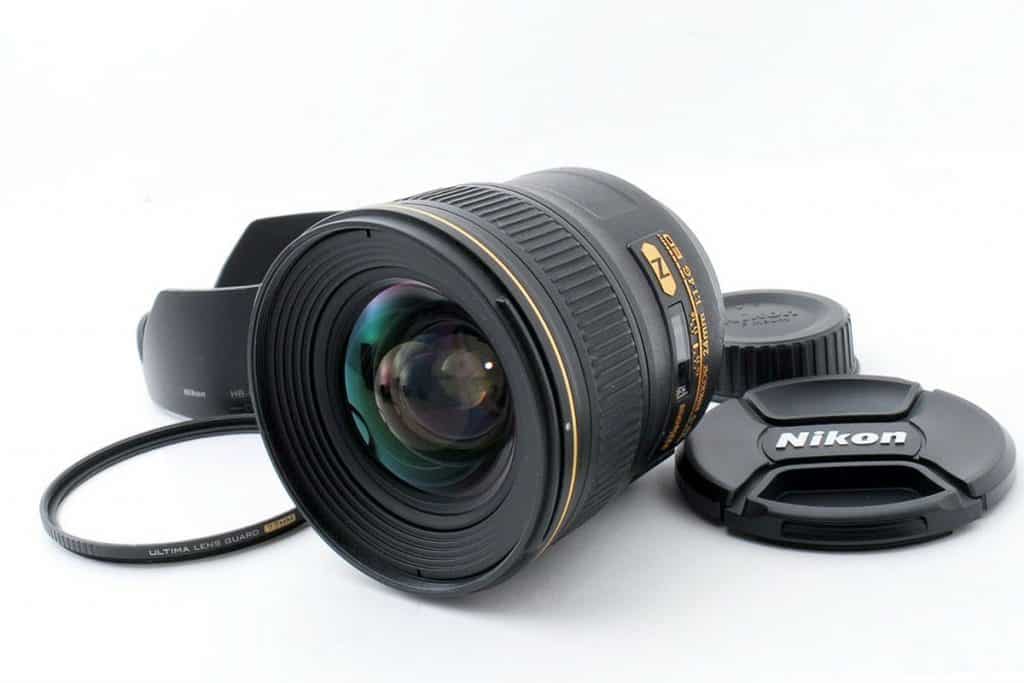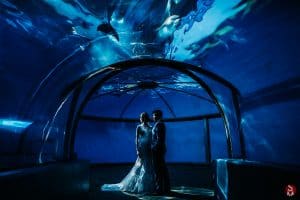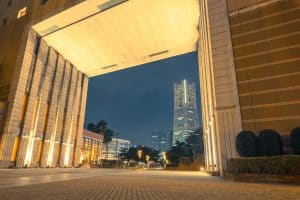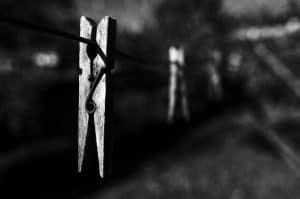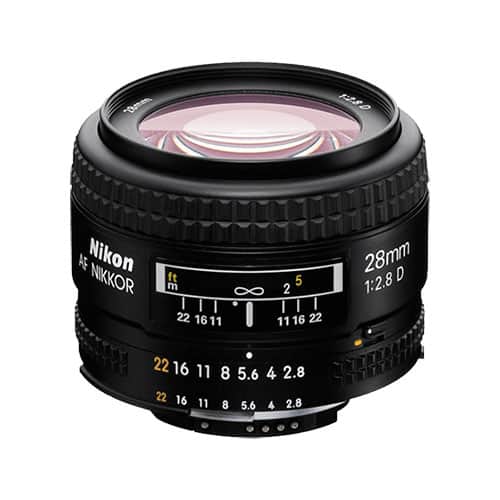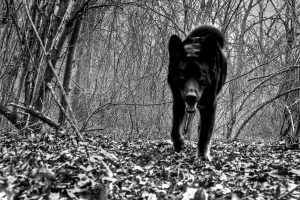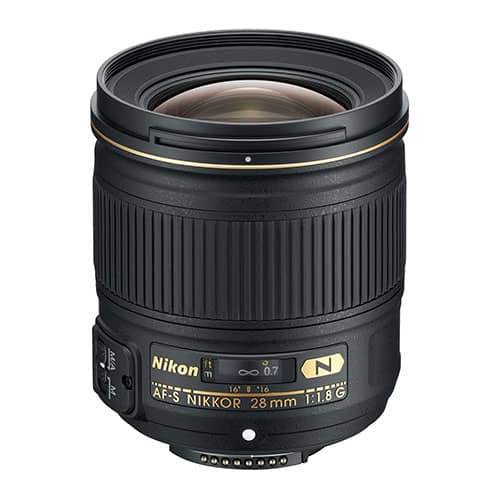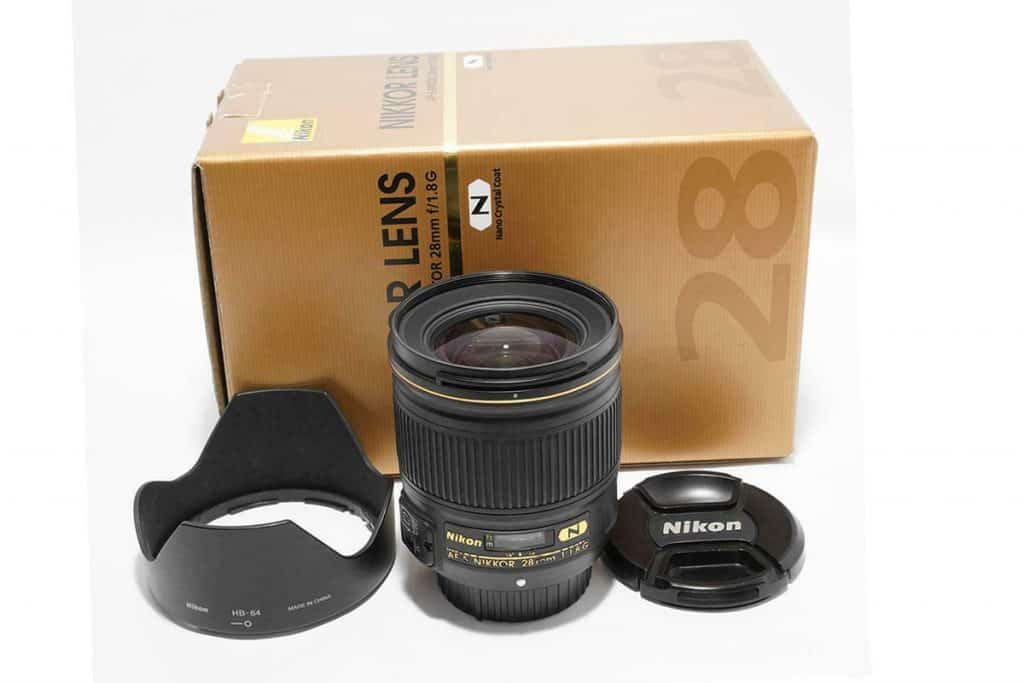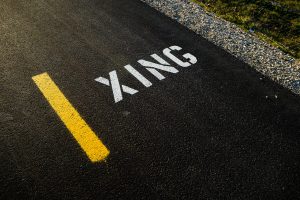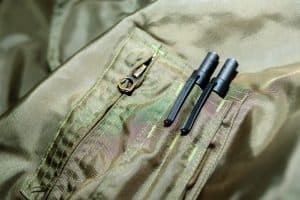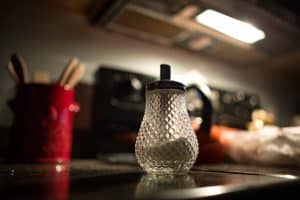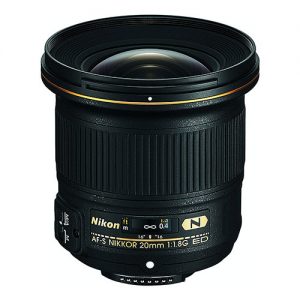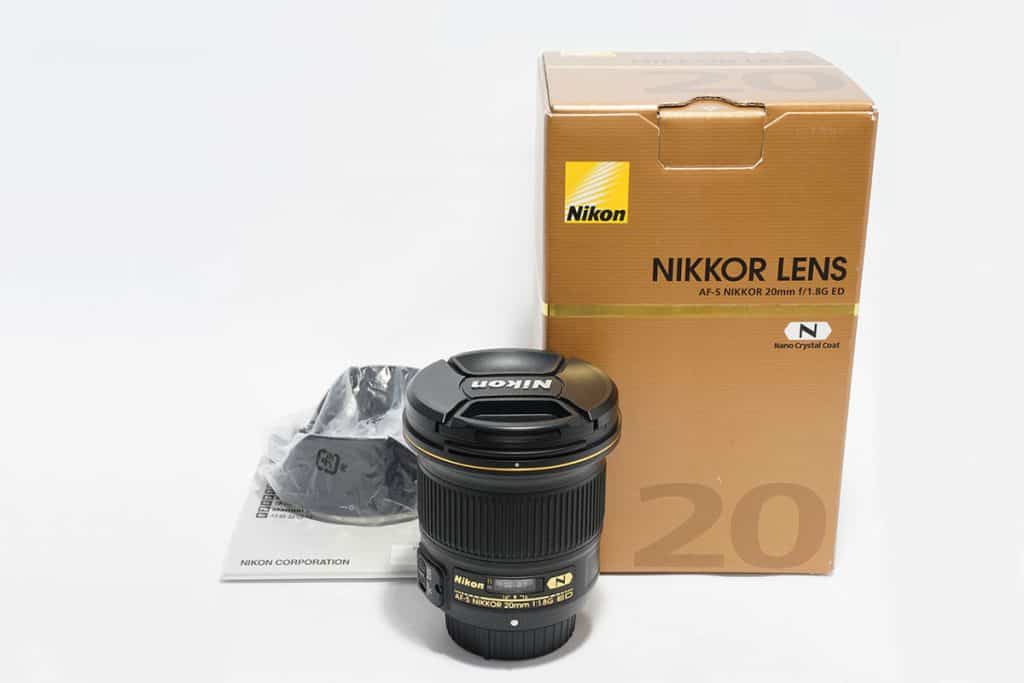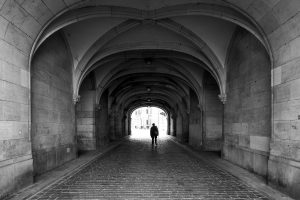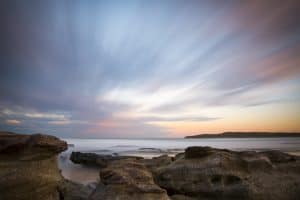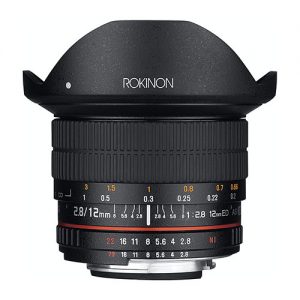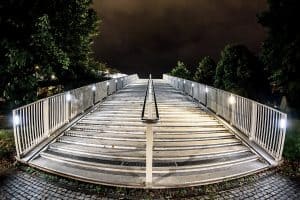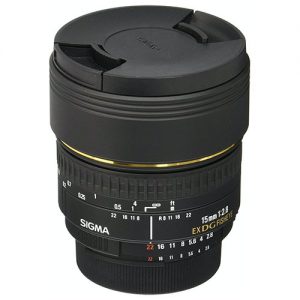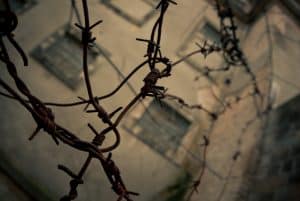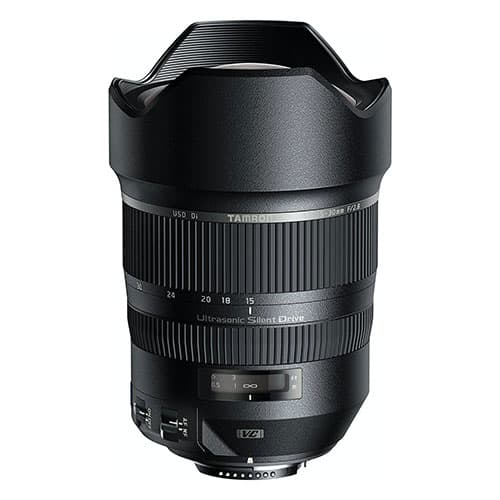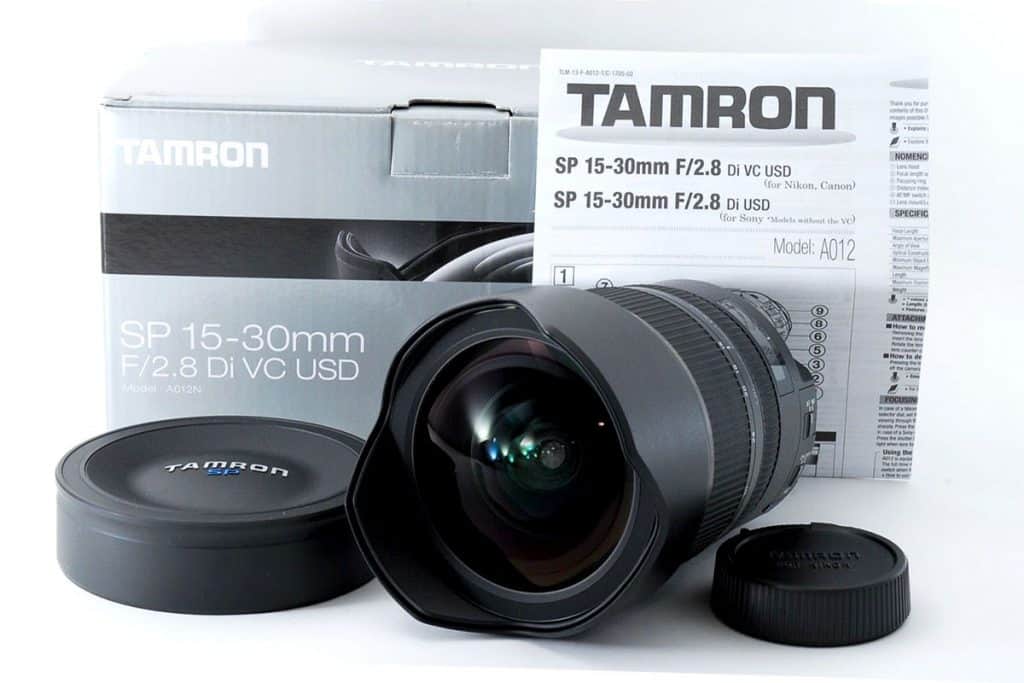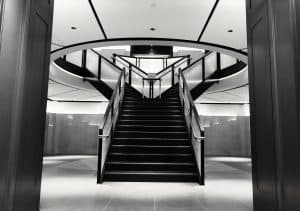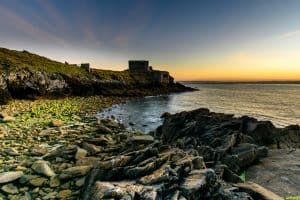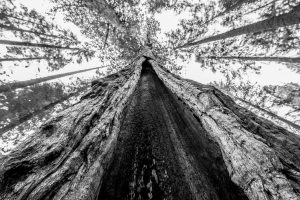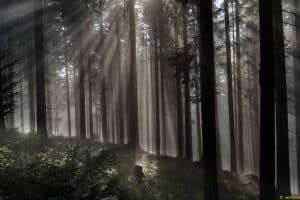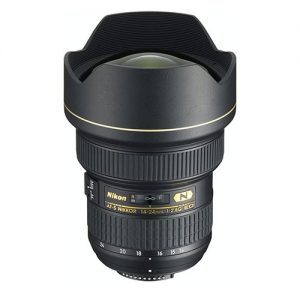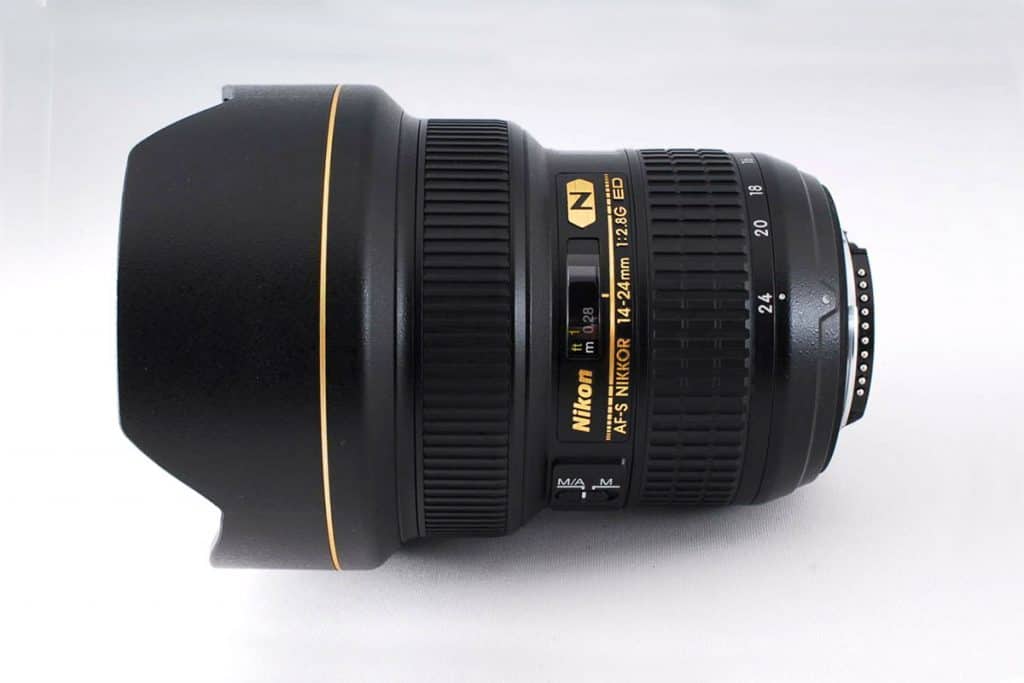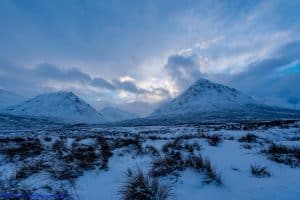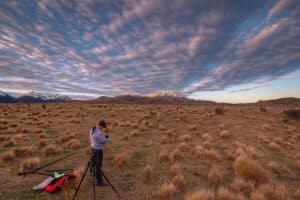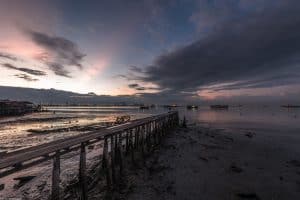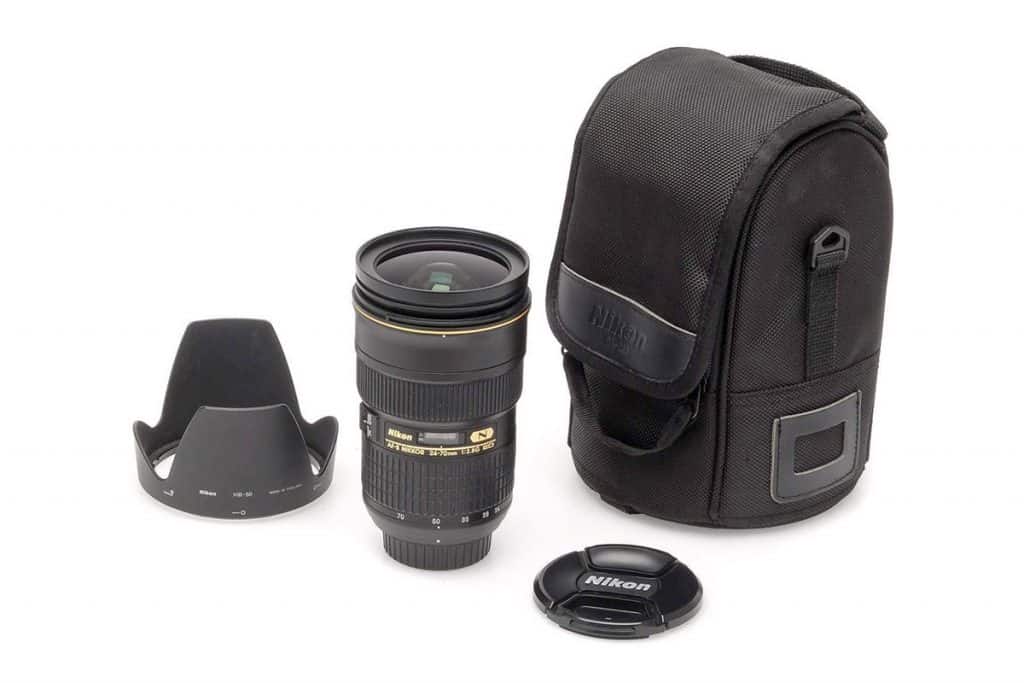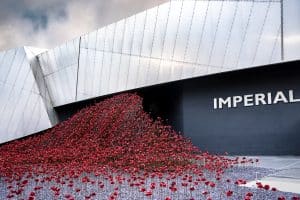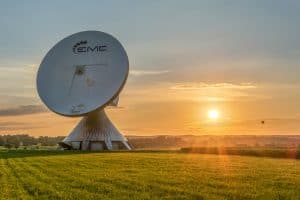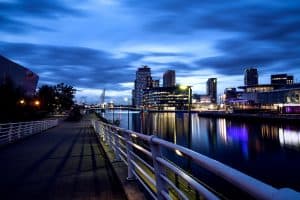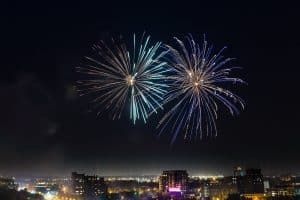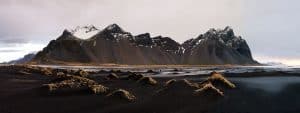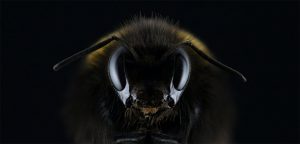A good wide angle lens can add drama and range to your photography. Since you can’t zoom in close to your subject with a wide angle lens, you can capture far more of a scene than you could with a non-wide angle lens.
Which lens you choose to buy will affect your photography and your wallet, so I’ve laid out the top 9 wide angle lenses for Nikon FX (Full Frame sensor) cameras here to help you can find the perfect lens for your needs.
First on our list is the granddaddy of wide angle prime lenses, and it is without a doubt the highest quality glass on this list.
At a 24mm focal length, it’s in the middle as far as extreme verses subtle wide angle, but what really sets this lens apart is its powerful f/1.4 aperture.
Much like the jump from f/2.8 to f/1.8, the jump to a f/1.4 aperture allows this lens to capture a great deal more light than any of the other Nikon FX wide angle lenses on this list.
This makes it the best for night sky photography, but also makes it great for capturing objects in motion, or really any shot you can think of.
A good aperture will always help you take better photos, no matter what the lighting. This lens is sharp and crystal clear at all apertures and it focuses incredibly quickly.
Of course, you get what you pay for. A lens this good doesn’t come cheap.
This is likely a lens for professional photographers. A hobbyist might not see the benefits clearly enough to justify such an expense.
But if you can get your hands on one (there’s always shopping used!), I highly recommend it. It captures stunningly beautiful wide angle images.
Next on our list is this simple 28mm lens.
I would definitely call this one an entry-level wide angle lens, which could be a great choice for you if you’re just starting out with wide angle photography and aren’t sure about committing to an expensive lens.
At under $300, it’s a great bargain, producing clear, sharp images for the price point.
A 28mm focal length is not an extreme wide angle, so this lens is versatile enough to be used for things like portraits and weddings as well as broader views.
That’s not true of some of the more extreme lenses later on this list, which you would not want to use to photograph people.
One fun thing to try with a wide angle lens is using it with a tripod and longer exposures for astrophotography.
With an f/2.8 aperture, this lens won’t capture quite as much light as some of the more expensive lenses with the same focal length, like the Nikon AF FX NIKKOR 28mm f/1.8.
But f/2.8 is a standard aperture for lenses at this price point and is perfectly acceptable for most well-lit situations.
As far as focusing, it can autofocus, but only if your camera has its own autofocus motor, which many newer cameras do.
But that’s worth checking for your camera if autofocus is important to you.
One detail to note about the lens is that it is a prime lens. This means it is not zoomable.
This might be a shortcoming for you if you are a new photographer and are used to using zoomable lenses, but prime lenses tend to be better quality than zoomable lenses.
And I think a big part of the fun of photography is moving around your subject to find the right distance and angle for the perfect shot. And working that way definitely has improved my own photos.
This lens has a lot in common with the first one I listed, the Nikon AF FX NIKKOR 28mm f/2.8D Lens. They are both Nikon NIKKOR brand, 28mm wide angle prime lenses.
But there is one major difference: the aperture. The first, less expensive lens has an f/2.8 aperture, and this one has an f/1.8.
It might seem like a small detail on paper, but this makes a great deal of difference in the performance quality of the lenses.
While both of the lenses are capable of capturing the same views, this lens can let in much more light through its aperture.
This, coupled with its powerful autofocus, means you can use quicker shutter speeds to capture objects in motion.
When you use slower shutter speeds, you get much more light hitting the sensor.
This means this is a perfect lens to try some astrophotography! I’m amazed by some of the results you can get with this lens when you open it up wide, point it at the sky, and hit the shutter.
That better aperture comes at a price. While the f/2.8 version was under $300, this one is just under $700. But something to keep in mind is that better apertures will always dramatically increase the price, so that’s not really a fault of this lens.
In fact, we’re headed to the part of the list where we’ll see some more expensive lenses overall. But more money pays for more quality.
It’s all a balance of your needs verses what you’re able to spend.
This lens has a lot in common with the previous one, so there isn’t a ton I can add about it, but the difference in focal length changes the types of pictures you can capture with it.
While both lenses have the same f/1.8 aperture for fast, high quality photos that capture a lot of light, this lens has a smaller focal length of 20mm.
This puts it somewhere between the 28mm lenses, which are still good for average subjects like portraits, and the more extreme fisheye lenses like the Rokinon and the Sigma, which are best for cool artistic shots.
his length is a nice balance of wide angle drama and usability.
20mm is one of my favorite focal lengths for architecture, because it’s wide enough to capture a lot of the building and get a small amount of artistic distortion but narrow enough to capture detail.
The price point on this lens is about the same as the previous one.
They have so much in common that I would choose to buy only one of them, depending on what focal length best fits your work. Getting both isn’t really necessary.
Before getting into too much detail about this Rokinon lens, something I want you to keep in mind is that you always have to check compatibility of a lens you buy online with your camera, especially for non-Nikon brand lenses.
Nothing worse than ordering a new lens and finding it doesn’t fit your camera!
There is a handy compatibility checker tool available on the Amazon listing page for this lens.
- Shot with this lens
This Rokinon 12mm lens has a link you can click to check your camera, and is compatible with most Nikon DSLRs, including DX mounts, which is nice if you have more than one camera body and like to switch lenses between them.
Just keep in mind the angle will be less wide on a DX than FX.
At a 12mm prime focal length, this starts to go into the extreme end of the wide angle spectrum (which is also what “fisheye” means in the name).
This is great for exciting and dramatic views, but not so great for portraits, because fisheye lenses tend to distort things.
This can be great for artistic effect, but bad if you’re photographing a bride on her wedding day. Definitely stick to landscapes, architecture, and even wildlife.
The images from this lens are sharp and clean for a lens under $400, but it is not autofocus compatible.
That may not be a huge problem depending on what you like to photograph. It can be a bit tricky to focus sometimes, but in general
I find focusing tends to be way easier at such wide angles, so no autofocus doesn’t bother me much on a lens like this.
Once again, this is a non-Nikon brand prime lens, so make sure your camera is compatible before buying.
In fact, this FX lens is pretty similar to the last one. There is a slight difference in focal length, which means this lens won’t have quite as extreme a fisheye effect as the Rokinon.
But the aperture is the same, so both lenses will capture similar amounts of light and both yield good, sharp images.

- Shot with this lens
Some key differences are that this lens is compatible with autofocus, so it is the clear winner if autofocus is important to you.
Another important consideration is that this is a diagonal fisheye lens. Sometimes fisheye photos have a dark ring around the outside, because the distortion is so extreme that the picture frame is a circle instead of a rectangle.
Diagonal fisheye lenses correct for this so the distorted image takes up the whole frame. This is a big plus!
Nothing in photography is free, so something to consider is that this lens is about $200 more expensive than the Rokinon.
Still a reasonable price for a good fisheye lens, though!
With this lens I want to introduce you to a new type of wide angle lens: the zoom wide angle.
While every lens on this list so far has been a prime lens, this one is a zoom.
That means that you can vary the focal length between 15mm and 30mm.
This is a nice compromise if you are interested in both extreme fisheye wide angle and more subtle wide angle effects. Zoom lenses combine the capabilities of both.
This does come at a slight cost of quality, however. Lenses are not great multitaskers. In general, the more jobs a single lens has, the more it might struggle to do them.
This is why prime lenses are considered the best, most high quality lenses, and also why high quality zoom lenses tend to be much more expensive.
This particular lens is a very good zoom lens, so it will take photos on par with cheaper prime lenses.
It even does fairly well with low light astrophotography! But it can’t really compete with the previous two prime lenses in terms of overall sharpness and clarity of the images, especially with an aperture of f/2.8 instead of f/1.8.
But the convenience of carrying around one zoom lens instead of multiple prime lenses is highly valuable if you’re traveling or shooting out in the field.
This is a fairly heavy lens at 2.5 pounds, so if you’re traveling with this lens it’s unlikely you’ll want to carry around much else.
This lens combines some of the features of the previous two lenses in terms of its range of zoom and its quality.
This wide angle zoom lens goes between 14-24mm, making its range more similar to the Tamron.
It’s definitely more on par with an extreme wide angle lens and can be used for more artistic shots. This is where this lens truly shines.
However, its quality and performance is a big step up from the Tamron, and more in line with the NIKKOR 24-70mm lens below.
Its price is close to that of the 24-70mm as well. It performs really well in low light, making it great for astrophotography, and it captures color beautifully.
It’s a powerful lens for landscapes, architecture, and night sky.
If you’re ready to make a serious investment in wide-angle photography, I think this is a truly excellent choice.
This is probably the most versatile lens on this list.
In fact, some might argue it’s not a true wide angle lens at all, but I still count it because it can go all the way down to 24mm, which is definitely a wide focal length.
But its ability to zoom all the way to 70mm, which is a medium telephoto length, makes it a highly adaptable lens.
You can use it to shoot wide scenes, or intimate portraits.
I love using a lens like this out in the field because you can shoot landscape and wildlife without switching lenses or cameras.
The overall quality of the images is exquisite for a zoom lens.
But at this point in the list, we’re only really seeing lenses with overall excellent performance.
Definitely a good enough lens for commercial-quality photography.
However, It’s quite expensive at just over $1400.
But for a lens that can do so many jobs, and very well at that, I think of it like an investment. Buying this one incredibly high-quality lens saves you from having to buy a few different, cheaper lenses.
If you’re committed to photography as a hobby, or are a professional investing in equipment, it’s definitely a justifiable purchase.
Your guide to choosing the right wide angle lens for your Nikon camera
What types of lenses are best for different types of wide angle photography?
Wide angle photography is a very broad category, since you can shoot almost anything with a wide angle lens, but some of the popular categories are architectural photography, landscape, astrophotography, and portraiture. Here’s some advice by category:
Architecture
One thing I really like when capturing photos of architecture with wide angle lenses is combining details from the buildings with broad, sometimes distorted views of the shape of the buildings. I think the best focal length for this type of photography is around 20-24mm.
Much lower and you get a highly distorted fisheye effect that can obscure the building (though this can be fun as well if used carefully!), but much higher and you may not capture the full scope of the scene. And unless you’re only shooting in the middle of the night, f/2.8 aperture should be just fine.
Landscape
My advice here is pretty similar to the architecture photos, but I think you can get away with an even lower focal length for landscapes since they’re often so broad, especially if you’re on top of a mountain or cliff.
A focal length of 15mm can be quite bold and dramatic for landscapes. I would also make sure you get yourself a graduated neutral density filter (GND) so your skies don’t come out too bright and the land too dark. That isn’t as much about the lens, but still important!
Astrophotography
Here I would say the wider the better so you can capture as much of the sky as possible. This would be a good time to experiment with some of those extreme fish-eye lenses.
And this is one case where aperture definitely matters. F/2.8 will work alright for astrophotography, but for the best results you really need a wider aperture to let in more light.
Otherwise you have to use a very slow shutter speed, which can result in stars trailing in the photo as they move across the sky (though this can be desirable sometimes!). F/1.8 or f/1.4 all the way!
Portraiture
This isn’t always considered a good wide angle subject, but you can take very good portraits with wide angle lenses if you are smart about your composition and choose the right lens.
First, this is not the time for the fisheye lens unless you and the subject agree that a distorted portrait is the goal.
The more extreme the wide angle, the weirder it will make a person look.
Second, you want to stage the portrait so it’s a broad scene containing a person, not so much a zoom in on their face.
A 28mm lens and a beautiful setting for portraits can yield great results.
What exactly do all those numbers and letters mean?
I mention these in the reviews, but let’s spell it out in a bit more detail so you can make the best choices possible on all your future lens purchases, not just wide angle lenses.
Focal length
The focal length is the number with the mm attached to it. It’s measured in millimeters and refers to the distance between where the light hits the lens and the image sensor.
It doesn’t necessarily relate to the actual size of the lens unit.
The idea around focal length is that the smaller your focal length is, the more of a scene you can capture, whereas larger focal lengths allow you to zoom in and capture closeups of your subject.
The most extreme of low focal length lenses are wide angle and fisheye lenses.
Aperture
The aperture is the number with an f/ before it.
This refers to how far the camera opens to let light in when you hit the shutter. It’s kind of confusing, but lower aperture numbers mean larger openings that capture more light. This means your shutter speed (the speed the aperture opens and closes) can be faster without losing light, which is great for moving subjects.
Unlike focal length, which only changes if you have a zoom lens, aperture can be adjusted manually or automatically by the camera for different kinds of shots.
The D and the G you sometimes see after aperture just refers to the presence or absence of a manual aperture setting ring.
This isn’t very important since the camera settings can do that for you on modern cameras.
Nikon FX, AF-S
The other letters and numbers refer to specific qualities of the lens and differ by brand. For example, FX means a full-frame camera (as opposed to DX, or a cropped camera) AF-S means single-shot autofocus (as opposed to AF-C, continuous shot autofocus).
It can be a lot of information, but the most important information for picking a lens is usually the focal length and the aperture.
Why are most of the lenses on your list Nikon NIKKOR? Aren’t there tons of different brands of lens?
This guide is specifically about FX (full frame) wide lenses.
And while there are a lot of brands out there, Nikon NIKKOR makes the most and the best lenses for full frame Nikon cameras.
You tend to find a lot more variety in brands and price points if you shop for lenses for a DX (crop frame) cameras. I did try to vary the brands on this list, but I kept coming back to Nikon NIKKOR for a reason. They work.
Why are lenses with the same wide focal length such different prices?
Focal length really only tells you the kind of lens it is, it doesn’t tell you much about the quality of the lens itself.
A 28mm lens might cost $200, or $2000. What determines the price of the lens is its build quality, whether it autofocuses, the type of glass put into it, and often its aperture.
These are the features to look for when you shop for lenses. Focal length is just a category!
What’s the deal with prime and wide angle zoom lenses? Which should I get?
This depends on the type of photographer you are! There are benefits to both types of lenses.
A prime lens only has one focal length, which means you’ll spend a lot of time as a photographer bouncing around your subject trying to find the right distance and angle to get the shot you need. I think this is a lot of fun, and a better way to take a lot of cool pictures than just sitting in one spot adjusting the zoom.
However, the downside to prime lenses is you can get a lot of similar compositions with the same focal length. Depending on your subject, it can be harder to mix it up and get a lot of unique photos.
On the other hand, zoom lenses work across a range of focal lengths, letting you greatly vary the types of photos you can take with just one lens.
This can be excellent if you do a lot of fieldwork or if you’re traveling and don’t want to be weighed down with a bunch of different prime lenses.
One factor to consider, however, is that it’s difficult to make zoom lenses that have the same image quality at a given focal length than its corresponding prime. If I try to take a photo at 24mm focal length with both a prime lens and a zoom lens at around the same price, there’s a good chance that the prime will take a better photo.
This is why really good zoom lenses can be really expensive. But if you’re using a zoom lens as a reason not to buy multiple prime lenses, it can be a great investment!
What focal length and aperture should I buy?
Don’t forget, focal length is just a category for lenses.
There’s no one right answer for that, but I’ll get to that in the next question.
For aperture, though, the answer is a bit more clean-cut.
Lower aperture numbers mean more light can be let into the camera for a given shutter speed. And because aperture can be varied with the camera settings, having a lower aperture number (AKA a wider aperture) only gives you more and better options as far as types of photos to take.
If you have a f/2.8 lens, you may take decent astrophotography shots, but you’ll probably get much better results with a f/1.8 lens of the same focal length.
But you could always shoot with the f/1.8 lens at f/2.8 by changing the camera settings! So, the f/1.8 lens can do things that the f/2.8 can’t, but the reverse isn’t necessarily true.
My advice on aperture is to get the widest aperture (lowest number) you can reasonably afford and are willing to spend the money on.
The price tends to rise dramatically between aperture numbers, so if you can only afford f/2.8, that’s just fine!
Truth be told, that will work for most situations. Wider apertures really are only necessary for situations with very low light or while trying to capture fast movement.
List of FX Mount (Full Frame) Nikon Cameras
The following Full frame Nikon DSLR cameras are directly compatible with FX lenses (source: Nikon USA)
- Nikon D3 (2007)
- Nikon D3X (2008)
- Nikon D3S (2009)
- Nikon D4 (2012)
- Nikon D4S (February 24, 2014)
- Nikon D5 (January 6, 2016)
- Nikon D800 / Nikon D800E (2012)
- Nikon D810 (June 26, 2014)
- Nikon D850 (August 24, 2017)
- Nikon Df (5 November 2013)
- Nikon D700 (2008)
- Nikon D750 (September 12, 2014)
- Nikon D780 (January 2020)
- Nikon D600 (13 September 2012)
- Nikon D610 (8 October 2013)
Final Words
Wide angle photography is wonderful and exciting, but I know it can also be confusing.
It’s tough to know what equipment to buy for what sort of job.
I hope this guide will help you pick your first wide angle lens for a nikon FX mount full frame camera, and maybe you even learned something about lenses in general for your future shopping.
What experiences have you had with wide angle lenses?
If you’ve tried any of these, how have they worked for you?
Do comment below. I’d love to hear from you. And happy shooting!

